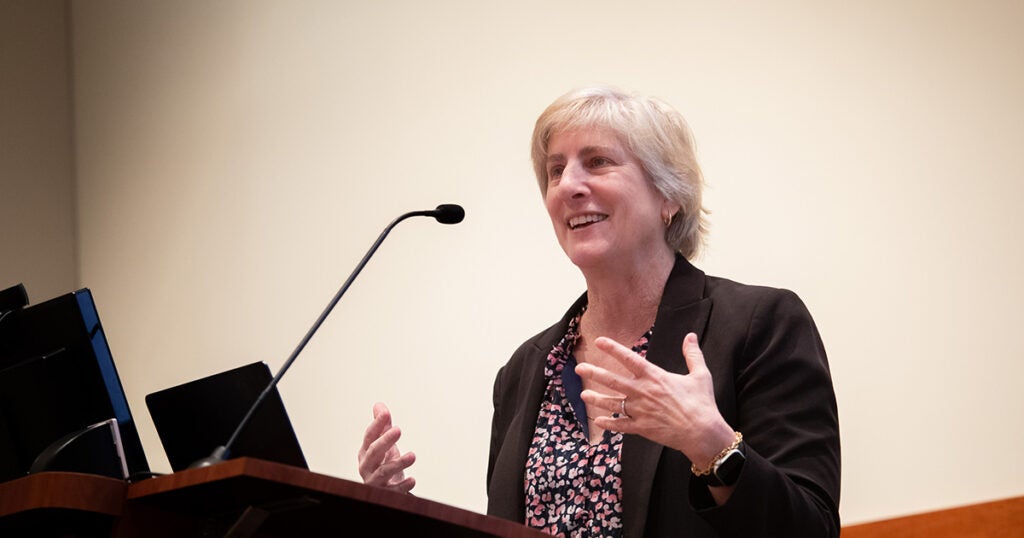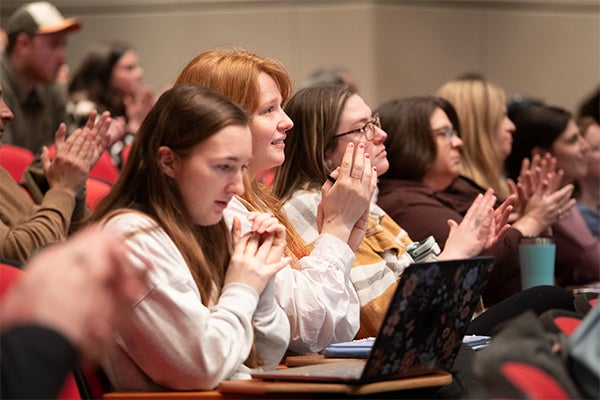National Academy of Sciences member shares genetics research, hope that assisted reproduction can be safer.
To Dr. Marisa Bartolomei, the investment East Carolina University has made in research is impressive.
Last month, the university was granted R1 status by the American Council on Education and the Carnegie Foundation for the Advancement of Teaching, and Bartolomei got an up close look when she visited the Brody School of Medicine and the Health Sciences Campus on Feb. 26.
“Clearly, you see the university doing a great job with training — and they’ve done a great job with recruiting,” she said.
Bartolomei is co-director of the Epigenetics Institute at the Perelman School of Medicine at the University of Pennsylvania and a 2021 inductee into the National Academy of Sciences. She is the world’s foremost expert on imprinted genes and mammalian epigenetics.
Her lecture at the East Carolina Heart Institute on imprinted gene expression and the impact of assisted reproductive technologies was titled “Mammalian reprogramming during development and under adverse environmental conditions.”

Dr. Marisa Bartolomei is the world’s foremost expert on mammalian epigenetics and a member of the National Academy of Sciences. She visited students and faculty at the Brody School of Medicine at East Carolina University last month to discuss her latest research and its impact on assisted reproductive technology. (Photo by Bobby Ampezzan)
“There is a level — a low level — of adverse outcomes in people who use IVF (in vitro fertilization) and assisted reproduction, and we’re starting to see the mechanism behind that that can lead to some improvements,” she said. “Some people don’t have such a problem [conceiving], but maybe we can optimize it to the point where everybody has an equal opportunity to have a healthy baby — that would be a really great outcome.”
As part of her two-day visit, Bartolomei met with students and faculty in the departments of anatomy and cell biology, physiology, biology, biochemistry and molecular biology, kinesiology and more. She capped her day at a Community and Connection Committee (Tri-C) roundtable on mentoring that met at Pitt Street Brewing Company.
“These students should feel like they can reach out to older generations of scientists,” she said, adding that this message of invitation and generational fellowship is especially urgent in the scientific community at the moment.
Bartolomei was invited to campus by Dr. Chris Geyer, an associate professor in the Department of Anatomy and Cell Biology at the medical school. He has known her since he was a graduate student, and she has served informally as a mentor through his entire career.
“I tell my Ph.D. candidates — this relationship is going to last as long as you want it to. It doesn’t end when you graduate,” he said. “Because you’re going to run into things that are hard to tackle.”
“Maintain these long relationships with people you trust.”
Gene Expression

Doctoral student Grace Neiswanger, a researcher in Dr. Chris Geyer’s lab, claps at the end of Dr. Marisa Bartolomei’s lecture. (Photo by Bobby Ampezzan)
It was as a postdoctoral fellow in the early 1990s that Bartolomei made a career-launching discovery, she told the March of Dimes last year. Mammalian cells contain chromosomes with pairs of genes, both of which are expressed. But they also contain a few hundred imprinted genes, which are unique in that only one allele in the pair is expressed. The other is repressed.
From her postdoctoral lab in New Jersey, Bartolomei discovered that a particular gene, H19, was critical in the embryonic stages of development and was imprinted — only the third one identified and named at the time.
Bartolomei left Princeton to start her own laboratory at the Perelman School of Medicine at the University of Pennsylvania, and she’s since built an impressive research portfolio with numerous important contributions to science. Recent work in her laboratory has shown that in vitro fertilization by its very processes creates an environment adversely impacts normal embryo development.
“Loss of imprinting, loss of methylation in imprinting control regions, was observed just for culturing embryos alone,” she told the scientists in the room.
Inheritance
Over 12 million babies have been born since 1978 when the first was conceived using in vitro fertilization.
“There are places in the world where ART (assisted reproductive technology) accounts for 5% of newborns, and we know ART is associated with adverse pregnancy outcomes, [such as] intrauterine growth retardation, preeclampsia, placental previa and accreta,” she said.
Bartolomei highlighted a handful of syndromes associated with physical or neurological maladies that have been traced to abnormal gene expression. One, Beckwith-Wiedemann syndrome, a congenital growth disorder, is diagnosed in 1 in 10,000 to 20,000 naturally conceived infants — but its rate is 1 in 900 in the IVF community.
“Just taking the embryo out and exposing it to pipets and oxygen and light,” as happens during the IVF protocol, she said, “could be sufficient to affect imprinted genes.”
More recent research in Bartolomei’s lab shows genomic imprinting defects beginning in the generation born after IVF — that is, the offspring of IVF males and females, conceived without assistance. Her lab found increased collagen in the testes of male offspring, smaller litter sizes and other impairments.
These are “changes in DNA methylation and gene expression clearly inherited through the IVF male.”

Dr. Leslie Kennedy, an assistant professor in the Department of Physiology, asks Dr. Marisa Bartolomei a question toward the end of her lecture inside the East Carolina Heart Institute auditorium. (Photo by Bobby Ampezzan)
After the lecture, Bartolomei stopped to have long conversations with several doctoral candidates and post doctoral researchers.
They were “friendly, interested — it’s been fun, and there’s lots of great young faculty here,” she said.
“You know, all the science can’t be done in the top five NIH-granting institutions alone. There’s really important reasons to do research everywhere. For the pipeline, the ideas — you get different ideas when you are in different places.”